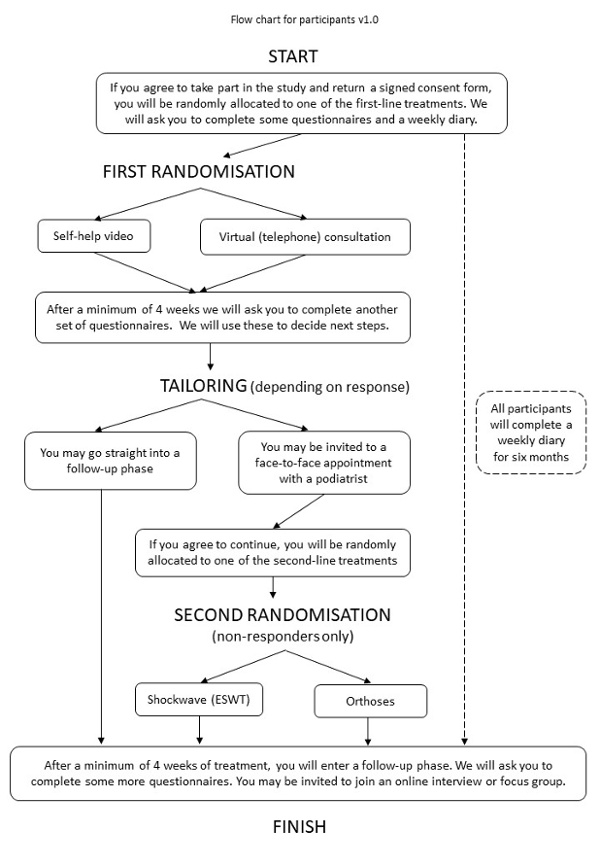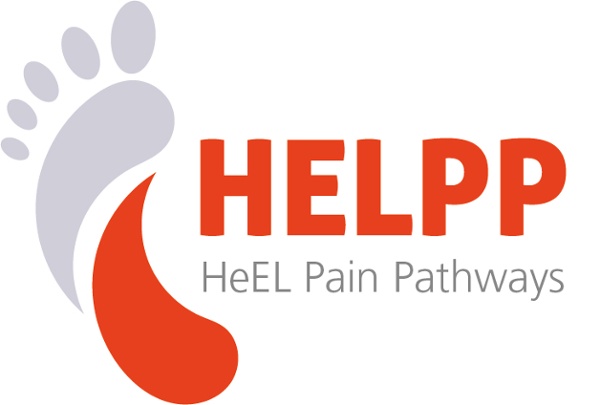HELPP (HeEL Pain Pathways) Feasibility Study
Lay summary
Background:
The plantar fascia is a thick band of tissue in the bottom of the foot that attaches to the heel bone. Inflammation of the plantar fascia can cause heel pain. This hurts so much that it limits movement and activities. It is very common - almost 1 in 10 middle-aged or older adults have experienced plantar heel pain. Each year, around 1,200 people with heel pain are referred to Cardiff and Vale University Health Board (CAVUHB) but the total number of people with heel pain across Wales is likely to be many more. This affects the health and wellbeing of our nation and that of the Welsh economy.
Treatments for heel pain include exercise advice, shoe insoles, and shockwave (ultrasound) therapy. The aim is to reduce pain and restore function. Each treatment can work better for some people than others. Recovery may be affected by age, weight or activity level. A patient-centred approach adapts treatments to suit individual people's needs. It aims to improve outcomes that matter to people with heel pain.
A recent study showed that patients want earlier access to self-help videos. They wanted more information on how different treatments work and which combination of treatments are most effective. However, without further research this postcode lottery of care will continue to exist across Wales.
Aim:
In the long term, we want to work with patients and NHS staff to find out which treatment pathways work best. This small feasibility study will help us to decide if a full-scale trial should go ahead.
Our feasibility study is step 3 in the following sequence: 1) Develop self-help video; 2) Review literature; 3) Single-site feasibility study; 4) Full-scale multicentre trial to test effectiveness; 5) Spread and scale implementation across Wales; 6) Share methods with other departments.
Approach:
Our feasibility study uses a new research design that looks at whole patient pathways instead of separate treatments. We will recruit 50 people referred to CAVUHB with ongoing heel pain. They will be allocated at random to different treatment pathways (known as adaptive interventions). All treatments are currently available in the NHS. We will collect study data from participants and staff using surveys, interviews, and focus groups.
What we hope to discover (objectives):
One of our key outcome measures is whether the tailored treatment pathways are acceptable to patients. Staff will also feed back their views about tailoring the adaptive interventions. We will learn how well our study design works, and how to improve it.
Public involvement:
We are actively partnering with patients and clinicians to co-produce this research proposal. One of our co-applicants leads a team of patient and public involvement (PPI) partners. Four people with lived experience of heel pain and a retired podiatrist helped to develop our PPI partnership plan. They have also advised on outcomes that matter most to patients.
Sharing our findings:
We will use our website, social media, and a newsletter to keep people up to date. At the end of the project, we will host a stakeholder feedback event where we will discuss what the results mean for our patients and for podiatry services in Wales. PPI partners will help to share our findings to the public. Other NHS staff and researchers may also want to adopt our methods to improve other clinical pathways in the future. We will share our findings with NHS networks, publish in an academic journal, and present at conferences.
Study details
- Full title of clinical trial: Feasibility of developing personalised treatment pathways for relief of plantar heel pain using a sequential multiple assignment randomised trial (SMART) study design
- Study design: Feasibility sequential multiple assignment randomised trial (SMART)
- Chief Investigator: Dr Nia Jones
- Sponsor: Cardiff and Vale University Health Board
- Sponsor ref: 8651
- Funding: Health and Care Research Wales - Research for Patient and Public Benefit
Flow chart for HELPP participants

